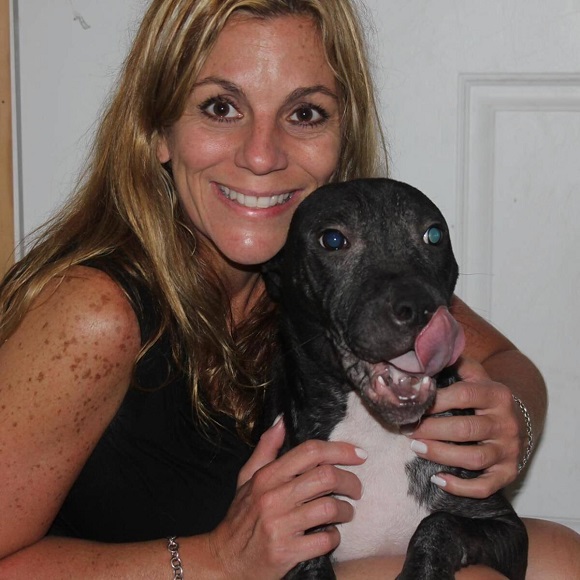How did you get into animal rescue?
I began rescuing in early 2000. A coworker’s brother needed to rehome his Cairn Terrier, named Dewey. Although my love of dogs and cats was instilled in me at a very young age, it wasn’t until 2007 that I began volunteering at a local shelter and learned the much needed skills to run a successful organization.
What was your reason for getting involved?
After several conversations with my coworker, it appeared that her brother was not able to give Dewey the time and attention he needed. I figured, if I intervened and took Dewey I can help train him and redirect his very high energy level, so that his next “person” has a clearer understanding of what exactly would work for Dewey to make him a great pet! And it proved successful! Dewey moved on to be an amazing family pet, his family understood exactly what Dewey required. Having three young children also helped to exhaust his energy! A successful placement is also about making the right match!
What is entailed in running a successful rescue?
Animal rescue is a labor of love! We run our organization like any other business, with a solid foundation in place. Ultimately, Four Paws Sake, NYC adheres to best practices, we have become more efficient and effective. This allows us as rescuers not only to humanely take in and adopt out more animals, but also build trust within the community, work successfully with other local animal welfare advocates and help solve problems of pet homelessness on a community level.
What do you do when you are over capacity and are contacted about cats/dogs in need of help?
We typically reach out to several well respected, reputable rescue organizations in the area and ask if they have the space.
Locally what would you like to see happen to help those that are involved in rescue (help from residents politicians, local businesses, etc.)?
I would like to see our local politicians support our work and understand the necessity for helping close puppy mills down by putting more bills in place. Adopting is one way to fight puppy mills. If you buy a dog from a pet store, from a breeder online, or a flea market, you’re almost certainly getting a dog from a puppy mill. Puppy mills are factory-style breeding facilities that put profit above the welfare of dogs. Animals from puppy mills are housed in shockingly poor conditions with improper medical care, and are often very sick and behaviorally troubled as a result. The moms of these puppies are kept in cages to be bred over and over for years, without human companionship and with little hope of ever joining a family. And after they're no longer profitable, breeding dogs are simply discarded—either killed, abandoned or sold at auction. These puppy mills continue to stay in business through deceptive tactics — their customers are unsuspecting consumers who shop in pet stores, over the Internet or through classified ads. Puppy mills will continue to operate until people stop supporting them. By adopting a pet, you can be certain you aren't giving them a dime.
What are the best and worst things about running a rescue?
Animal rescue is among the most difficult work out there. Every day we witness some of the very worst of human behavior and it breaks our hearts. But we also work with some of the most caring and passionate individuals who are dedicated to saving as many lives as possible. While we spend so many resources caring for the animals, we often forget to care for ourselves as well as the thousands of other people in the animal welfare community. The homeless animal issue is a problem bigger than any one organization can solve. Only through a comprehensive and collaborative approach will we be successful. No single organization can do it alone and we have a responsibility to foster a culture of respect within our own organizations and extend it to others. Between the seemingly endless flow of homeless animals and the abuse and cruelty we see on a daily basis, it is easy to become overwhelmed with compassion fatigue, also known as secondary post-traumatic stress disorder. Some signs of compassion fatigue are negativity, lack of accountability, high turnover, long-lasting illnesses that never seem to resolve, infighting, resistance to change, feeling powerless, feeling apathetic about work and feeling trapped. Oftentimes this stems from the sadness and guilt that arises from not being able to save every animal coupled with pent-up frustration from dealing with careless people.
What is the one thing you would like everyone reading this to know about rescuing?
Each year, 3.9 million adoptable dogs and cats are euthanized in the United States, simply because too many pets come into shelters and too few people consider adoption when looking for a pet. The number of euthanized animals could be reduced dramatically if more people adopted pets instead of buying them. When you adopt, you save a loving animal by making them part of your family and open up shelter space for another animal who might desperately need it. By adopting an animal, you’re making room for others. Not only are you giving more animals a second chance, but the cost of the adoption goes directly towards helping our next rescue we take in. Usually when you adopt a pet, the cost of spay/neuter, first vaccinations (and sometimes even microchipping!) is included in the adoption fee, which can save you some of the upfront costs of adding a new member to your family. Depending on the animal, you may also save on housebreaking and training expenses. “No one needs to see another selfie—unless it’s a selfie of you with the adorable pet you just adopted! Adopt don’t shop!




